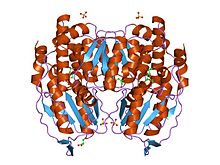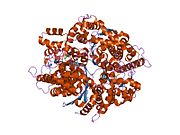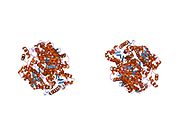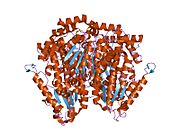Glucose-6-phosphate isomerase
| Glucose-6-phosphate isomerase | |||||||||
|---|---|---|---|---|---|---|---|---|---|
ExPASy NiceZyme view | | ||||||||
| KEGG | KEGG entry | ||||||||
| MetaCyc | metabolic pathway | ||||||||
| PRIAM | profile | ||||||||
| PDB structures | RCSB PDB PDBe PDBsum | ||||||||
| Gene Ontology | AmiGO / QuickGO | ||||||||
| |||||||||
| Bacterial phosphoglucose isomerase C-terminal region | |||||||||
|---|---|---|---|---|---|---|---|---|---|
 crystal structure of phosphoglucose/phosphomannose isomerase from pyrobaculum aerophilum in complex with fructose 6-phosphate | |||||||||
| Identifiers | |||||||||
| Symbol | bact-PGI_C | ||||||||
| Pfam | PF10432 | ||||||||
| InterPro | IPR019490 | ||||||||
| CDD | cd05016 | ||||||||
| |||||||||
| Phosphoglucose isomeras | |||||||||
|---|---|---|---|---|---|---|---|---|---|
| Identifiers | |||||||||
| Symbol | PGI | ||||||||
SCOP2 | 1pgi / SCOPe / SUPFAM | ||||||||
| CDD | cd05015 | ||||||||
| |||||||||
Ensembl | |||||||||
|---|---|---|---|---|---|---|---|---|---|
| UniProt |
| ||||||||
| RefSeq (mRNA) |
| ||||||||
| RefSeq (protein) |
|
| |||||||
| Location (UCSC) | Chr 19: 34.36 – 34.4 Mb | n/a | |||||||
| PubMed search | [2] | [3] | |||||||
| View/Edit Human | View/Edit Mouse |
Glucose-6-phosphate isomerase (GPI), alternatively known as phosphoglucose isomerase/phosphoglucoisomerase (PGI) or phosphohexose isomerase (PHI), is an enzyme ( EC 5.3.1.9) that in humans is encoded by the GPI gene on chromosome 19.[4] This gene encodes a member of the glucose phosphate isomerase protein family. The encoded protein has been identified as a moonlighting protein based on its ability to perform mechanistically distinct functions. In the
Structure
Functional GPI is a 64-kDa dimer composed of two identical monomers.[6][7] The two monomers interact notably through the two protrusions in a hugging embrace. The active site of each monomer is formed by a cleft between the two domains and the dimer interface.[6]
GPI monomers are made of two domains, one made of two separate segments called the large domain and the other made of the segment in between called the small domain.
It is hypothesized that serine phosphorylation of this protein induces a conformational change to its secretory form.[7]
Mechanism
The mechanism that GPI uses to interconvert glucose 6-phosphate and fructose 6-phosphate (aldose to ketose) consists of three major steps: opening the glucose ring, isomerizing glucose into fructose through an enediol intermediate, and closing the fructose ring.[10]
Isomerization of glucose
| D-Glucose | Phosphoglucose isomerase
|
D-Fructose | |

|

| ||

| |||
Phosphoglucose isomerase
|
|||
| α-D-Glucose 6-phosphate | Phosphoglucose isomerase
|
α-D-Fructose 6-phosphate | |

|

| ||

| |||
Phosphoglucose isomerase
|
|||
Compound C00668 at KEGG Pathway Database. Enzyme 5.3.1.9 at KEGG Pathway Database. Compound C05345 at KEGG Pathway Database. Reaction R00771 at KEGG Pathway Database.
Glucose 6-phosphate binds to GPI in its pyranose form. The ring is opened in a "push-pull" mechanism by His388, which protonates the C5 oxygen, and Lys518, which deprotonates the C1 hydroxyl group. This creates an open chain aldose. Then, the substrate is rotated about the C3-C4 bond to position it for isomerization. At this point, Glu357 deprotonates C2 to create a cis-
When going from fructose-6-phosphate toward glucose-6-phosphate, the result could be mannose-6-phosphate if carbon C2 is given the wrong chirality, but the enzyme does not permit that result except at a very low, non-physiological, rate.[11]
Function
This gene belongs to the GPI family.[5] The protein encoded by this gene is a dimeric enzyme that catalyzes the reversible isomerization of G6P and F6P.[12][13] Since the reaction is reversible, its direction is determined by G6P and F6P concentrations.[9]
glucose 6-phosphate ↔ fructose 6-phosphate
The protein has different functions inside and outside the cell. In the
Neuroleukin
Though originally treated as separate proteins, cloning technology demonstrated that GPI is almost identical to the protein neuroleukin.
Autocrine motility factor
Cloning experiments also revealed that GPI is identical to the protein known as autocrine motility factor (AMF).
Prokaryotic bifunctional glucose-6-phosphate isomerase
In some
Clinical significance
A deficiency of GPI is responsible for 4% of the hemolytic anemias due to glycolytic enzyme deficiencies.[12][13][25][26] Several cases of GPI deficiency have recently been identified.[27]
Elevated serum GPI levels have been used as a prognostic
Applications
Human GPI is capable of inducing arthritis in mice with varied genetic backgrounds via intradermal injection.[29][30]
See also
- Fructose-1-phosphate-aldolase enzyme, which converts fructose to glucose
Interactions
GPI is known to
Interactive pathway map
Click on genes, proteins and metabolites below to link to respective articles.[§ 1]
- ^ The interactive pathway map can be edited at WikiPathways: "GlycolysisGluconeogenesis_WP534".
References
- ^ a b c ENSG00000105220 GRCh38: Ensembl release 89: ENSG00000282019, ENSG00000105220 – Ensembl, May 2017
- ^ "Human PubMed Reference:". National Center for Biotechnology Information, U.S. National Library of Medicine.
- ^ "Mouse PubMed Reference:". National Center for Biotechnology Information, U.S. National Library of Medicine.
- ^ "UniProtKB: P06744 (G6PI_HUMAN)".
- ^ a b "Entrez Gene: GPI glucose phosphate isomerase".
- ^ PMID 10653639.
- ^ PMID 11004567.
- ^ PMID 10318897.
- ^ PMID 12573240.
- PMID 11371164.
- ^ PMID 15342241.
- ^ PMID 10916680.
- ^ PMID 21970785.
- S2CID 39800980.
- PMID 8674049.
- S2CID 4260489.
- PMID 3764429.
- PMID 3020690.
- PMID 8674049.
- PMID 8392842.
- ^ PMID 21252914.
- PMID 3085086.
- ^ PMID 23248119.
- PMID 15252053.
- PMID 8499925.
- PMID 8822954.
- ^ "GPI Deficiency". Archived from the original on 2014-05-17. Retrieved 2012-12-23.
- PMID 24440856.
- PMID 23911657.
- PMID 19660107.
Further reading
- Walker JI, Faik P, Morgan MJ (August 1990). "Characterization of the 5' end of the gene for human glucose phosphate isomerase (GPI)". Genomics. 7 (4): 638–643. PMID 2387591.
- Brownstein BH, Silverman GA, Little RD, Burke DT, Korsmeyer SJ, Schlessinger D, Olson MV (June 1989). "Isolation of single-copy human genes from a library of yeast artificial chromosome clones". Science. 244 (4910): 1348–1351. PMID 2544027.
- Mizrachi Y (June 1989). "Neurotrophic activity of monomeric glucophosphoisomerase was blocked by human immunodeficiency virus (HIV-1) and peptides from HIV-1 envelope glycoprotein". Journal of Neuroscience Research. 23 (2): 217–224. S2CID 42567893.
- Gurney ME, Apatoff BR, Spear GT, Baumel MJ, Antel JP, Bania MB, Reder AT (October 1986). "Neuroleukin: a lymphokine product of lectin-stimulated T cells". Science. 234 (4776): 574–581. PMID 3020690.
- Faik P, Walker JI, Redmill AA, Morgan MJ (March 1988). "Mouse glucose-6-phosphate isomerase and neuroleukin have identical 3' sequences". Nature. 332 (6163): 455–457. S2CID 4306026.
- Zanella A, Izzo C, Rebulla P, Perroni L, Mariani M, Canestri G, et al. (1981). "The first stable variant of erythrocyte glucose-phosphate isomerase associated with severe hemolytic anemia". American Journal of Hematology. 9 (1): 1–11. S2CID 10479146.
- Faik P, Walker JI, Morgan MJ (May 1994). "Identification of a novel tandemly repeated sequence present in an intron of the glucose phosphate isomerase (GPI) gene in mouse and man". Genomics. 21 (1): 122–127. PMID 7545951.
- Xu W, Beutler E (December 1994). "The characterization of gene mutations for human glucose phosphate isomerase deficiency associated with chronic hemolytic anemia". The Journal of Clinical Investigation. 94 (6): 2326–2329. PMID 7989588.
- Xu W, Lee P, Beutler E (October 1995). "Human glucose phosphate isomerase: exon mapping and gene structure". Genomics. 29 (3): 732–739. PMID 8575767.
- Baronciani L, Zanella A, Bianchi P, Zappa M, Alfinito F, Iolascon A, et al. (September 1996). "Study of the molecular defects in glucose phosphate isomerase-deficient patients affected by chronic hemolytic anemia". Blood. 88 (6): 2306–2310. PMID 8822952.
- Beutler E, West C, Britton HA, Harris J, Forman L (December 1997). "Glucosephosphate isomerase (GPI) deficiency mutations associated with hereditary nonspherocytic hemolytic anemia (HNSHA)". Blood Cells, Molecules & Diseases. 23 (3): 402–409. PMID 9446754.
- Kanno H, Fujii H, Miwa S (March 1998). "Expression and enzymatic characterization of human glucose phosphate isomerase (GPI) variants accounting for GPI deficiency". Blood Cells, Molecules & Diseases. 24 (1): 54–61. PMID 9616041.
- Kugler W, Breme K, Laspe P, Muirhead H, Davies C, Winkler H, et al. (October 1998). "Molecular basis of neurological dysfunction coupled with haemolytic anaemia in human glucose-6-phosphate isomerase (GPI) deficiency". Human Genetics. 103 (4): 450–454. S2CID 8313584.
- Belyaeva OV, Balanovsky OP, Ashworth LK, Lebedev YB, Spitsyn VA, Guseva NA, et al. (April 1999). "Fine mapping of a polymorphic CA repeat marker on human chromosome 19 and its use in population studies". Gene. 230 (2): 259–266. PMID 10216265.
- Yakirevich E, Naot Y (April 2000). "Cloning of a glucose phosphate isomerase/neuroleukin-like sperm antigen involved in sperm agglutination". Biology of Reproduction. 62 (4): 1016–1023. S2CID 22985905.
- Haga A, Niinaka Y, Raz A (July 2000). "Phosphohexose isomerase/autocrine motility factor/neuroleukin/maturation factor is a multifunctional phosphoprotein". Biochimica et Biophysica Acta (BBA) - Protein Structure and Molecular Enzymology. 1480 (1–2): 235–244. PMID 11004567.

























